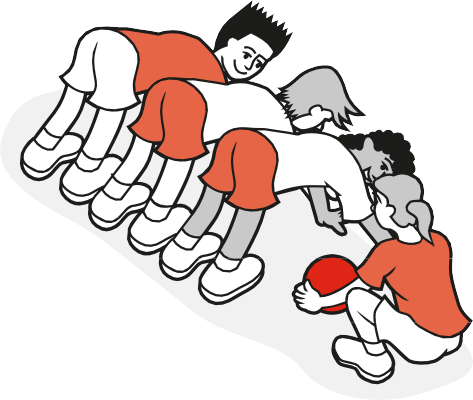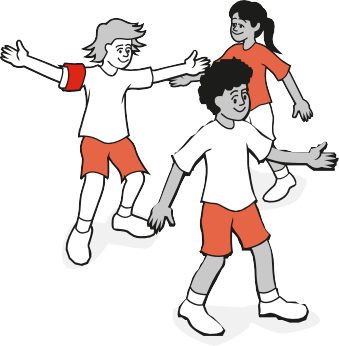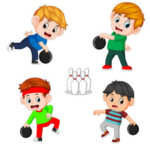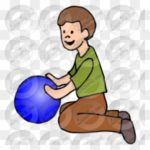
by Santosh | Jun 4, 2020 | Fitness Activity
Movement skills/concepts
Dynamic balance; slow, sustained walking; and balancing.
Set-up
Hard court area.
Activity
The aim of this race is to be the last to finish.
All children line up on the start line. On a signal, children race as slowly as they can to the finish line. Children must be moving at all times. Any child who stops is out of the race.
Can you see …?
• arms stretched out for balance
You could ask …
How will you keep your balance when you are moving slowly?
Variations
Vary locomotor skill: Use hopping, walking or jumping.
COOL DOWN/ CLOSURE
Review Skill/Activity, stretching, and questions.

by Santosh | Jun 4, 2020 | Fitness Activity
Movement skills/concepts
Static balance, throwing, running, and relationships (with others).
Set-up
Mats, balls.
Groups of five–seven, with a ball per group. Children are standing, lined up one behind the other with their feet spread in a straddle position.
Activity
Roll to the back: The child at the front of the line rolls the ball under everyone’s legs to the back person, who retrieves the ball and runs to the front. Repeat in the new positions.
Front support: Two children are at either end of a ‘tunnel’ created by the rest of the group, who begin on hands and knees side by side on the floor and then, on a signal, lift up into a front support to form the tunnel. The child in front of the tunnel rolls the ball to the child at the back, who then runs to the front. The child at the front joins the start of the tunnel and the child at the end of the tunnel disengages from the tunnel to receive the ball.
Can you see …?
• tight muscles
• being still
You could ask …
How can you hold the front support position?
Variations
Vary static balance position: Try a ‘V’ sit or back support, and throw the ball over and roll under. Have a race with another group and see who finishes first.
COOL DOWN/ CLOSURE
Review Skill/Activity, stretching, and questions.

by Santosh | Jun 4, 2020 | Fitness Activity
Movement skills/concepts
Walking, dynamic balance and space awareness.
Set-up
Hard area defined by cones or lines; bibs or bands.
Children spread out along lines/cones: two children are taggers, who wear bands.
Activity
On a signal, children walk along the lines, trying to avoid being tagged. They can change direction, but cannot jump to other lines.
If tagged, a child puts on a band and begins to tag others.
Can you see …?
• walking only on the lines
• arms extended for balance
You could ask …
How will you use the lines to avoid being tagged?
Variations
Vary locomotor skills: Use skipping, running or hopping.
Modify rules: Children can jump lines, or coach/teacher calls out specific lines that are safe (e.g. only vertical lines or curved lines).
COOL DOWN/ CLOSURE
Review Skill/Activity, stretching, and questions.

by Santosh | Jun 4, 2020 | Fitness Activity
Movement skills/concepts
Static balance, locomotor skills, evading a tagger and space awareness.
Set-up
Children are spread out in a defined grass or hard surface area: one or two children are taggers; the rest are runners.
Activity
Taggers try to tag the runners. If tagged, a runner becomes ‘stuck in the mud’ and holds a static balance (e.g. straddle, scale balance, front support) until released.
To release a stuck child, a free runner must crawl under, step over or run around them, with the movement depending on the stuck runner’s static position.
Can you see …?
• head up to see others
• tight muscles to hold balance
You could ask …
Taggers: How will you work together to tag the runners?
Runners: What can you do to hold your balance while you wait to be freed?
Variations
Vary locomotor and balance skill: Try hopping or skipping as locomotor skill, and front support as balance skill.
COOL DOWN/ CLOSURE
Review Skill/Activity, stretching, and questions.

by Neetu | Jun 4, 2020 | Fitness Activity
Movement skills/concepts
Underarm throw for accuracy.
Set-up
Small balls, bucket/bin/box, targets on wall, ground targets like hoops, rope circles, bases, discs, markers as tees.
Activity 1: Frogs
- Each group of two-three, with one ball, is spaced around a bucket.
- Players take turns throwing
- the ball into the bucket. How many
- times can you throw the balls into the bucket?
Activity 2: Underarm darts
In a group of two-three, each player has a ball and stands in front of a wall target (numbers in a square, or a circle with several rings, like a dartboard).
Throw underarm five times and count your score.
Activity 3: Underarm golf
Ground targets (holes) are arranged as a ‘golf’ course, positioned at varying distances from one another and with a marker (tee) near each one.
Players throw from the starting tee until they can land the ball on the full on the first target. They continue in this way round the rest of the course, following the correct sequence.
Can you see …?
- eyes on target
- long arm swing
- stepping towards target
- following through
You could ask …
If you increase the distance from the target, what happens to your arm swing? To hit the target consistently, what do you need to focus on?
Variations
Increase difficulty: Increase the distance between tee and target.
Play with a partner: Have a competition to see who can score the most points with a limited number of throws.

by Neetu | Jun 4, 2020 | Fitness Activity
Movement skills/concepts
Rolling to a target, space awareness, and relationships (with others).
Set-up
- Balls.
- Smooth surface.
- Each group of six or eight stands in a circle about 4 meters in diameter. Opposite players are a pair: they have the same number and have one ball between them.
Activity
The player who has the ball rolls it across the circle to their partner, and then the other pairs of players do the same in quick succession. See how quickly they can complete this task.
Can you see …?
- ball in fingers
- stepping and rolling
- following through
Variations
Change the order of the rolls: The sequence goes from the pair with the highest to the pair with the lowest numbers, or from odds to evens, or in random order.
Increase the number of balls: Every player has a ball, with partners rolling to each other at the same time.
Vary equipment and skills: For example, in soccer, kick pass, or hockey push pass/hit.











